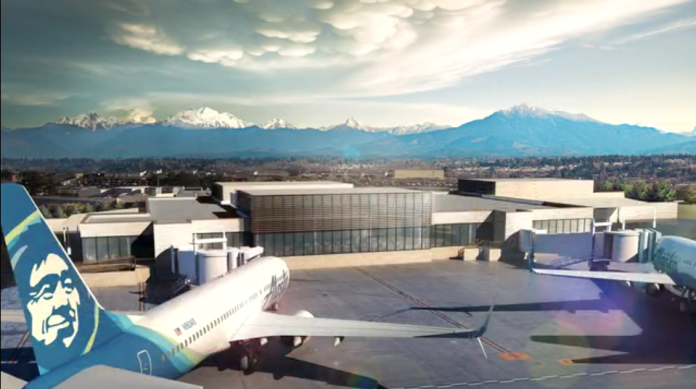The Puget Sound Regional Council (PSRC) has narrowed the field of possible sites that a second major airport could be located by 2040. In the latest round of the Regional Aviation Baseline Study, the PSRC has identified four locations that could rival Sea-Tac International Airport. Underpinning the study is the assumption that Sea-Tac will reach capacity, even with planned improvements and expansions, by 2032 and that demand will grow far beyond that capacity in the following decades. One forecasted estimate suggests that regional demand will grow 22 million annual passenger enplanements by 2050, but without a new airport or two, that would demand would go unmet.
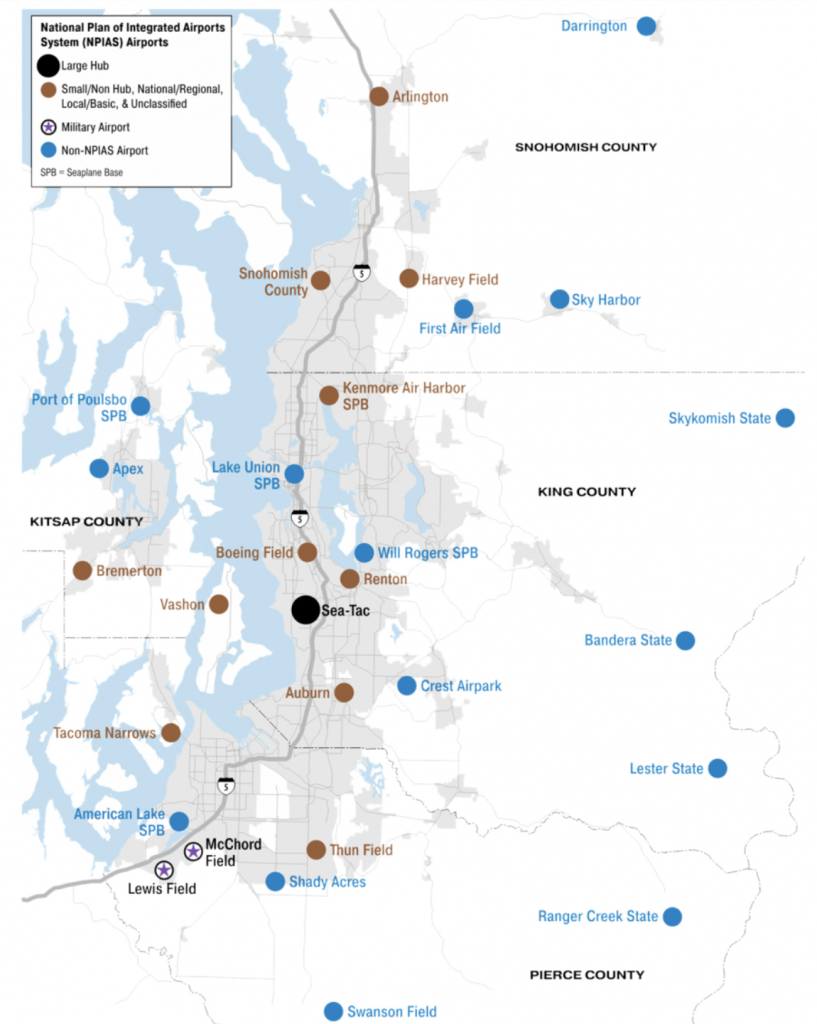
During the 30-year period, the PSRC assumes that growth in aviation will continue despite occasional periods of economic upheaval like the current pandemic. Regional demand in commercial service, for instance, is expected to grow from 24 million annual enplanements in 2018 to somewhere between 49.3 million and 55.6 million annual enplanements by 2050. This translates to a growth in commercial service demand of 105% to 132%, which is a huge leap that would necessitate the equivalent of at least one new Sea-Tac Airport. In tandem with this passenger growth, annual takeoffs and landings would grow from 438,000 in 2018 to somewhere between 810,000 and 914,000 by 2050. Likewise, air cargo is expected to continue ballooning with globalization of the economy and heavier reliance on e-commerce. Regional air cargo demand is expected to more than double by growing from 552,000 metric tons in 2018 to 1,300,000 by 2050.
The PSRC has outlined three different scenarios:
- Scenario 1 – Meeting 50% to 60% of demand;
- Scenario 2 – Meeting 80% of demand; or
- Scenario 3 – Meeting 100% of demand.
Scenario 1 is essentially a no change scenario, which maintains capacity at Sea-Tac and Paine Field (with its 24 daily flights) and assumes that Sea-Tac implements the approved long-term plan for expansion (increasing gates from 83 to somewhere between 105 and 113), but nothing more. The PSRC assumes that the scenario would leave demand unmet by 22 million to 27 million annual enplanements by 2050.
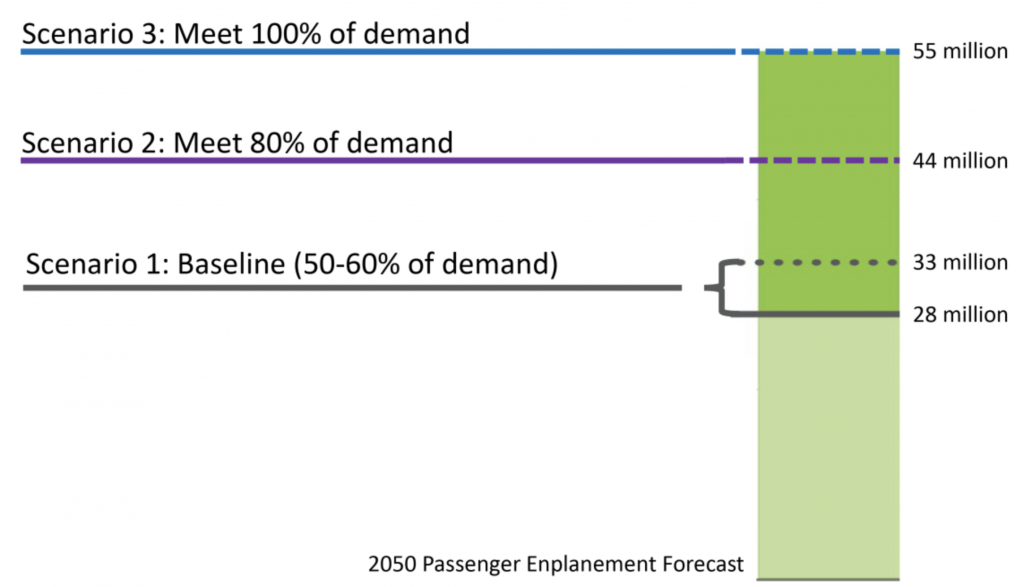
Scenario 2 builds upon Scenario 1 by expanding one or more airports in the region that would accommodate an additional 11 million annual enplanements. This would either require at least one additional airport to have two parallel runways that are 7,000 feet long or two airports that each have at least one runway that is 7,000 long.
Scenario 3 also builds upon Scenario 1 by expanding one or more airports in the region that would accommodate an additional 27 million annual enplanements. This would require at least one additional airport to have three parallel runways that are 7,000 feet long or two or three airports that provide the same a cumulative number of runways in combination.
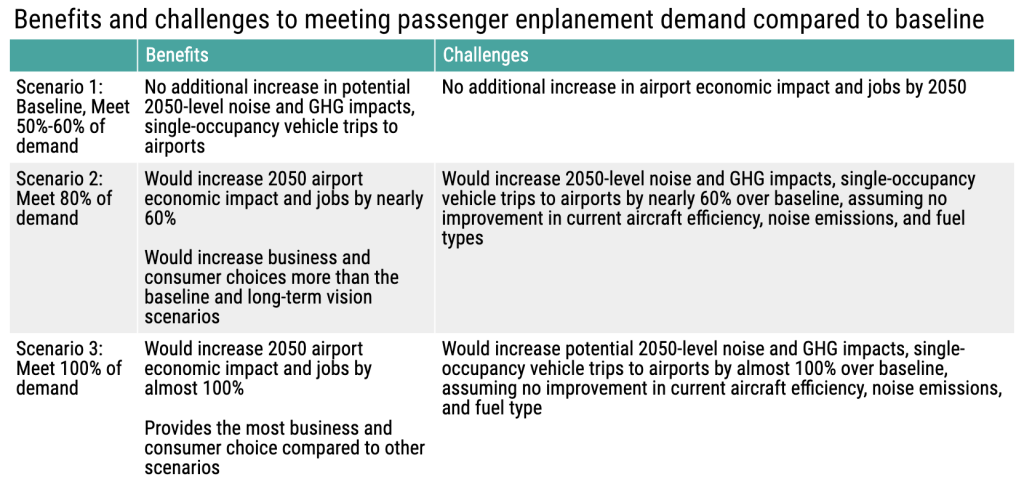
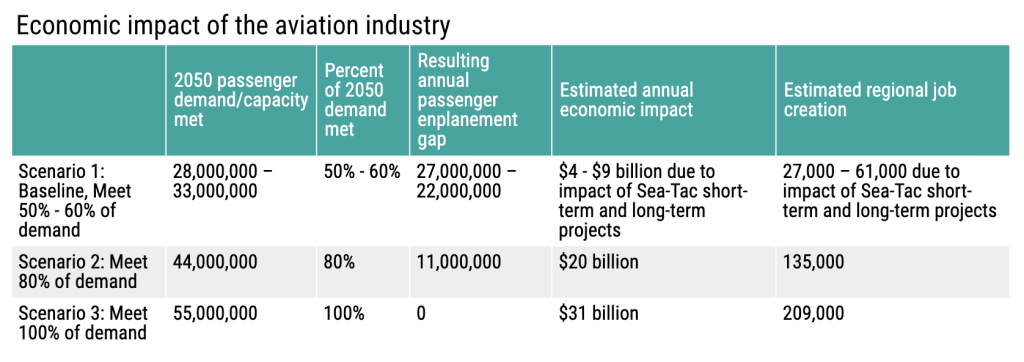
In short-listing airports that might be able to fit the bill for expansion, the PSRC used a variety of criteria, including the following:
- “Ability to accommodate single or parallel runways”;
- “Existing airspace constraints or conflicts”;
- “Impact to Sea-Tac aircraft operations (airspace)”;
- “Flood zone hazard”;
- “Ownership”;
- “Current and future roadway and transit access”;
- “Incompatible land use within a mile of 7,000-foot or 9,000-foot runway ends”;
- “Ability to accommodate additional aircraft operations”;
- “Impact to aerospace manufacturing”; and
- “Population and employment within 60-minute drive time”.
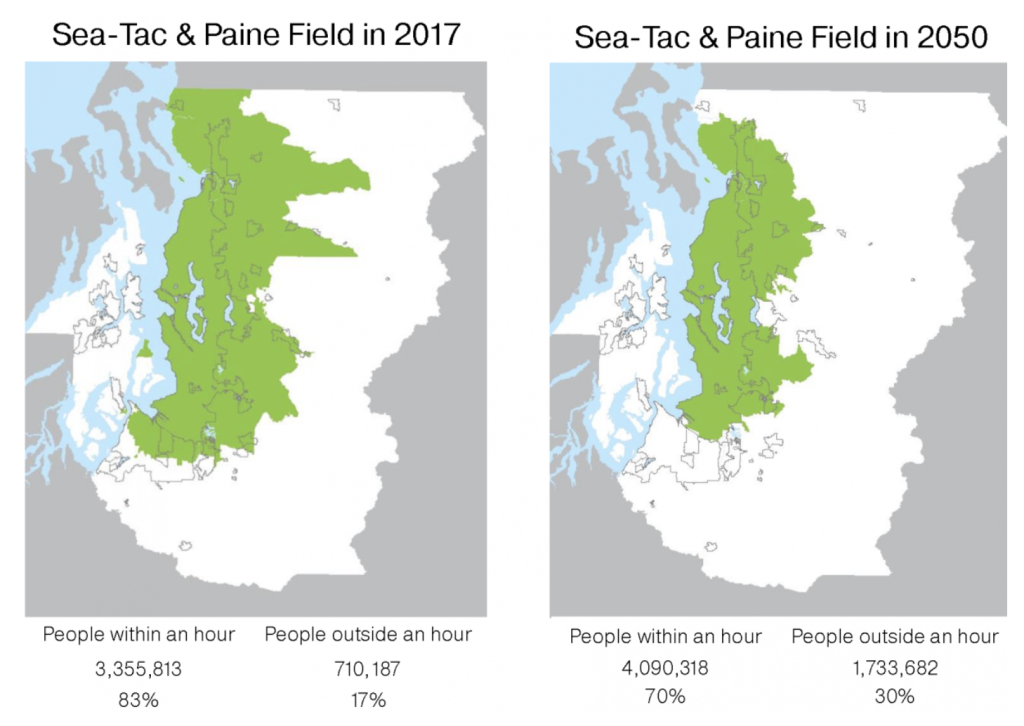
Four existing airports met the criteria in Snohomish, Pierce, and Kitsap Counties. These include the Arlington Municipal Airport, Bremerton National Airport, Paine Field Airport, and Tacoma Narrow Airport. The PSRC’s analysis of the airports indicates the following:
- Arlington Municipal Airport is capable of supporting a runway that is 7,000 to 9,000 feet long. However, the airport may be challenged in support two parallel runways of that length. In terms of compatibility, the airport expansion would not pose a threat to local aerospace manufacturing and development in the area does not pose serious conflicts or constraints on airspace. The PSRC also finds that the highway access to the airport is relatively good and that high-capacity transit could serve the airport. Drive-time access is projected to only increase 60-minute drive-time to the airport for 1% of region’s population.
- Bremerton National Airport is capable of supporting at least one runway that is 7,000 to 9,000 feet long with the possibility for parallel runways. In terms of compatibility, the airport expansion would not pose a threat to local aerospace manufacturing, but the airport could be constrained by airspace due to the proximity to Sea-Tac flightpaths over Puget Sound and military operations nearby. The PSRC also finds that the airport does not have good highway access and that there are limited options for high-capacity transit service to the airport. Drive-time access is projected to increase 60-minute drive-time to the airport for 14% of region’s population and 12% of the region’s employment.
- Paine Field Airport could be expanded and provide for one runway that is 7,000 to 9,000 feet long, however, the airport would not likely be able to have a second parallel runway that meets separation requirements. Additionally, expanding commercial service could negatively impact local aerospace manufacturing, but expanding service would not run up against airspace constraints. The PSRC also finds that the airport does not have good highway access and that there are limited options for high-capacity transit service to the airport–though it’s the only one in Sound Transit 3 light rail plans. Drive-time access is not projected to increase 60-minute drive-time to the airport for the region’s population and employment.
- Tacoma Narrows Airport is capable of supporting a runway that is 7,000 to 9,000 feet long and might be able to accommodate parallel runways of similar length. In terms of compatibility, the airport expansion would not pose a threat to local aerospace manufacturing, but the airport could be constrained by airspace due to the proximity to Sea-Tac and Boeing Field flightpaths over Puget Sound and military operations nearby; Sea-Tac traffic operations could also be impeded by the airport. The PSRC, however, finds that the airport has good highway access and that there may be options for high-capacity transit service to the airport. Drive-time access is projected to increase 60-minute drive-time to the airport for 22% of region’s population and 15% of the region’s employment.
While much of the study is focused on commercial service demands, the PSRC notes that air cargo will remain an important consideration in airport capacity and growth. The main challenge for air cargo is ground-related capacity at airports, which are primarily located at Sea-Tac and Boeing Field. The PSRC has identified several ways of increasing air cargo capacity in the years ahead:
- “Make better use of space and facilities at Sea-Tac and accommodate air cargo warehouse and distribution at off-airport facilities”;
- “Develop air cargo facilities at Paine Field”;
- “Use Grant County Moses Lake International Airport during cherry season”;
- “Shift peak season traffic to Spokane International Airport”;
- “Develop non-urban airports as ground-based logistics/distribution centers”;
- “Build multi-story logistics facilities”; and
- “Create a regional cargo community system to increase efficient use of available facilities”.
One glaring aspect of the study is that there is little emphasis on environmental impacts and considerations. At the outset, the PSRC dispenses with the effect that high-speed rail could have on regional air travel due to the small market share of regional flights even though enormous sums of jet fuel and carbon emissions on use for low productivity destination pairs. 350 Seattle, a local environmental organization, has panned the study. “Unfortunately, the study reads like a pitch piece for the aviation industry,” the organization notes. “The study’s one mention of climate includes outdated and incomplete information on aviation greenhouse gas (GHG) emissions: only 10% of 2015 aviation emissions are included, and the study makes no mention of the disparate impacts of aviation air and noise pollution on marginalized communities.”
350 Seattle is urging that the public comment on the study. The organization specifically suggests the following comments:
- “The study must include complete and current information on GHG emissions from aviation, namely all emissions from the fuel pumped at airports in our region.”
- “The study must recognize that aviation emissions have a two to four times greater warming impact than on-the-ground emissions.”
- “The study must acknowledge the environmental injustice of aviation and center the voices of impacted communities.”
Entirely separate from the PSRC, the state is leading a conversation on where a second major airport should be sited in the state. This, however, is widely understood to mean the Central Puget Sound, so there is some overlap in the work the two agencies are doing. Recommendations from the state should be forthcoming end of next year. Meanwhile, the PSRC’s baseline aviation study online open house runs through the end of today (October 19th) with a short online survey.
Stephen is a professional urban planner in Puget Sound with a passion for sustainable, livable, and diverse cities. He is especially interested in how policies, regulations, and programs can promote positive outcomes for communities. With stints in great cities like Bellingham and Cork, Stephen currently lives in Seattle. He primarily covers land use and transportation issues and has been with The Urbanist since 2014.

